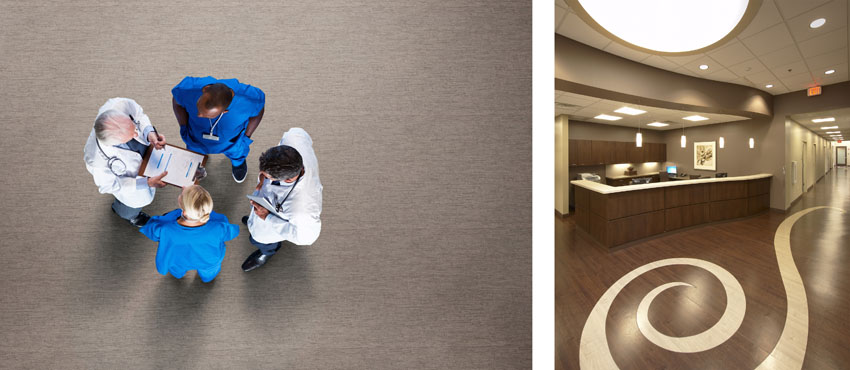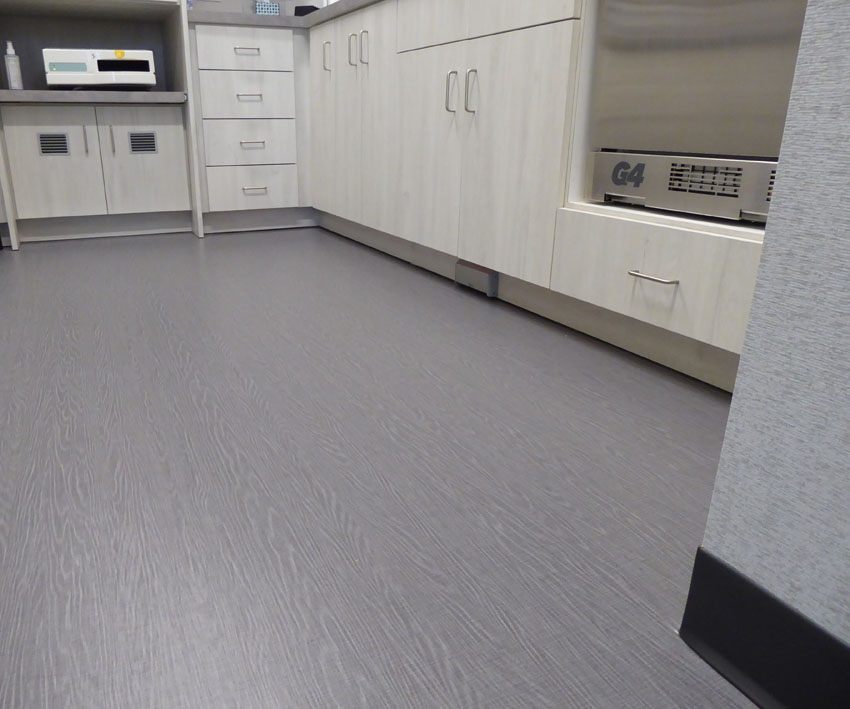Healing Environments for Health Care
Handrails Addressing Multiple Safety Issues

Images courtesy of Inpro
Interior elements such as wall handrails in health-care and mental health facili-ties need to be addressed for their ability to curtail patient harm in addition to being a walking aid and wall-protection item.
Handrails are commonly used along interior corridor walls in health-care facilities to assist patients with stability and mobility when walking. However, in certain cases, such as mental health facilities, everything needs to be scrutinized for preventing patients from inflicting harm on themselves, including handrails. An open handrail could become a place for a suicidal patient to attach or tie something around and attempt self-harm.
Recognizing this issue, at least one manufacturer has developed an innovative handrail system that eliminates any gap between the handrail and the wall. It is based on a continuous aluminum retainer and solid one-piece returns to reduce wedge points where anything could be affixed. The continuous retainer works in tandem with the solid one-piece wall returns. The top of the vinyl cover sets within the integrated aluminum channel, removing a pick point, while the oval-shaped top rail provides a comfortable and secure surface for gripping and leaning.
Based on all of these attributes, this new handrail offers an innovative, easy-to-install railing system that is a durable, stylish, and ligature-resistant option for behavioral health facilities. In fact, this type of handrail is the only one accepted for use by the New York State Office of Mental Health (NYSOMH). A midsize version of the handrail (45/16 inches, or 110 millimeters, in height) also offers wall protection with a lower profile than conventional handrail products. It is available in standard solid colors and simulated wood patterns.
FLOORING
There are many options for floor coverings in health-care facilities, but one of the go-to choices for many design professionals is vinyl flooring. There are a lot of reasons for this, not the least of which is the virtually endless color and design selections, including vibrant colors, textured patterns, and material replication such as wood or stone that play well in contemporary health-care designs. Vinyl flooring is typically less expensive than many other options in part because it is easy to install, including the ability to affordably create coved wall bases for more hygienic installations. From an operations standpoint, vinyl flooring is resistant to moisture, stains, insects, mold, and mildew, plus it is easy to clean, offers low maintenance, and is extremely durable. There are patient reasons to consider vinyl flooring as well, such as noise-reducing qualities. A cushion underlayment can be put under the vinyl flooring, which helps to absorb sound from footsteps and creates a quieter, more desirable place to be.
With all of these attributes making vinyl flooring appealing for health care, a closer look is worthwhile as follows.
Sheet Vinyl or Tile?

Photos courtesy of Lonseal Flooring
Sheet vinyl flooring has been used very successfully in health-care settings to create a variety of looks in different colors, material appearances, and patterns.
Sheet vinyl flooring is most often used in areas where seams need to be as nonexistent as possible. Health-care facilities are such an area since the seams or joints in any flooring, including some tiles, can breed bacteria or mold and jeopardize meeting hygiene requirements. Using seamless or welded seamed sheet vinyl flooring eliminates the concern altogether. Some products are also available with increased infection control through an antimicrobial formulation.
One of the main reasons why architects choose sheet vinyl flooring is that it can be printed in a wide range of different looks. Unlike vinyl tiles, sheet flooring allows the creation of very large designs or images that do not force a floor based on repeating smaller patterns. Nonetheless, if a tile or plank look is desired, that too can be printed without the concern of the joints or seams. Sheet vinyl can also be fabricated to look like a number of different materials such as wood, stone, and cloth in a variety of tones and colors. Many of these options can also be specified with a factory-applied urethane-finish top surface. This treatment protects the floor pattern, reduces scuffing, and simplifies routine maintenance. As such, it extends the life of the flooring by protecting it from wear. Overall, all of these attributes of sheet vinyl floor make it particularly well suited to produce an appealing health-care experience and still perform to meet the needs of the staff.
Green Building Attributes

Photo courtesy of Lonseal Flooring
Biophilic design was used for the flooring of this endodontist clinic to cre-ate a more natural pattern and help ease the anxiety of patients and staff.
There have been notable advances in the way resilient sheet vinyl is pursuing and achieving greater sustainability and green building recognition. Of course, not all vinyl flooring is made the same. There are some bargain-priced products that consist of a basic and minimum formulation to be considered resilient and can typically wear out within five years. High-quality vinyl flooring is formulated with higher quality and can last up to 10–20 years—which is clearly a more sustainable solution. Some of the eco-friendly features found in quality vinyl flooring can be summarized as follows:
- LEED contributions: High-quality vinyl interior flooring products are available that contribute toward LEEDv4 Building Product Disclosure: Environmental Product Declarations (EPDs) (Option 1). This qualifies the materials and sources using an industry-wide EPD. They can also contribute toward the Sourcing of Raw Materials (Option 2), which means the products have post-industrial recycled content, commonly ranging from 10–20 percent, with some reaching 50 percent or more. Interior flooring products and adhesive products are also available to meet the requirements of Indoor Environmental Quality credits for general emissions evaluation and VOC content requirements.
- FloorScore certification: This well-known program from the Resilient Floor Covering Institute (RFCI) and Scientific Certification Systems independently tests and certifies flooring products for compliance with indoor air-quality emission requirements. Some products have recently been developed and certified for low VOC content, a notable distinction from other products.
- Collaborative for High Performance Schools (CHPS): Some manufacturers are a member of and meet the standards for the CHPS program, a well-known green building rating system especially designed for schools but used as a benchmark for other settings too.
- ISO 9001 and 14001 compliance: Flooring products can be specified to be obtained from a facility that has certifications from the International Organization for Standardization (ISO), which provides a rigorous external third-party verification process. Specifically, ISO 9001: Quality Management Systems ensures a manufacturer’s compliance to its own internal quality standards. In addition, ISO 14001: Environmental Management Systems addresses ever-changing environmental laws and regulations.
While vinyl flooring manufacturers have made great progress in recent years, some are never satisfied with the status quo and are always striving to raise the bar with ever-more eco-friendly products and new product offerings. Some monitor the use of recycled pre- consumer (post-industrial) content, achieving an average of 20–50 percent recycled content. They also promote the factory-applied, urethane finish, which, due to their low-maintenance and matte finish, reduces the chemicals required during maintenance from finishes and strippers.
In the spirit of healthier indoor environments, at least one manufacturer has embraced the idea of biophilic design for it vinyl flooring products. Biophilia is simply our native tendency to want to connect with nature and has been found to have a significant impact on health and well-being. Products are available that use the science behind biophilia studies and incorporate colors, patterns, and textures that are reminiscent of outdoor settings as a result. Patterns that are most likely to hold our attention and reduce eye-muscle fatigue are typically those found in nature. Incorporating such patterns into health-care settings can contribute to the overall sense of satisfaction and a positive experience for everyone in the facility.
Lace Greene-Cordts is the marketing manager for Lonseal flooring. Reflecting on the industry and its engagement with green building principles, she comments, “Being ‘green’ is no longer enough—products need to contribute to the physiological needs architects are now providing in building designs.” She goes on to point out that “a good design is something that will allow a user perception to process an experience toward healthy and restorative feeling.” Working with manufacturers to understand their specific product offerings can help design professionals make the best selections and achieve the ideal results in health-care projects.
Notice

www.aamsco.com/mirrors/wheelchair-medicine-chest


www.inpro.com

www.kohler.com

www.lonseal.com

www.waclighting.com









